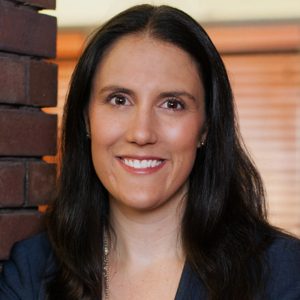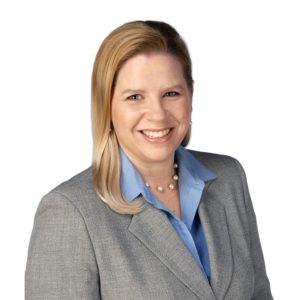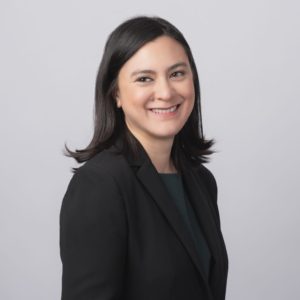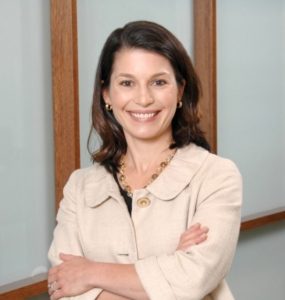Our Spotlight on Flex showcases professionals from member organizations who exemplify personal and professional success while working a flexible schedule. Their stories illustrate the long-term benefits that flexible schedules offer to both individuals and organizations.
October 2020 Spotlight on Flex
For our October Spotlight on Flex, we’re pleased to highlight Tessa Mielke Partner, Dorsey & Whitney (Minneapolis, MN)
Diversity & Flexibility Alliance: How have you made flexibility a priority and a success with your schedule?
 Tessa Mielke: I graduated from law school in 2010 when the legal world seemed to be upside down (though it was certainly less crazy than now!). Because of the Great Recession, I had the opportunity to spend a year working at Harvard Law School’s transactional law clinic before transitioning to a full time associate role in the tax group in the Boston office of Ropes & Gray. In 2013, my husband started his medical residency in Minneapolis; I left Ropes and started at Dorsey & Whitney in their tax, trusts and estates group. I was working a typical full time associate schedule, but reevaluated my work schedule in 2015 after my first child was born. She had a few health concerns, including needing major surgery on her skull (she’s fine now!). I decided to reduce my hours so I could take my daughter to her numerous medical appointments without worrying about the hours I was missing at work.
Tessa Mielke: I graduated from law school in 2010 when the legal world seemed to be upside down (though it was certainly less crazy than now!). Because of the Great Recession, I had the opportunity to spend a year working at Harvard Law School’s transactional law clinic before transitioning to a full time associate role in the tax group in the Boston office of Ropes & Gray. In 2013, my husband started his medical residency in Minneapolis; I left Ropes and started at Dorsey & Whitney in their tax, trusts and estates group. I was working a typical full time associate schedule, but reevaluated my work schedule in 2015 after my first child was born. She had a few health concerns, including needing major surgery on her skull (she’s fine now!). I decided to reduce my hours so I could take my daughter to her numerous medical appointments without worrying about the hours I was missing at work.
I switched to an 80% reduced hours schedule with the intention of ramping back up to full time once we were done with my daughter’s medical appointments. But once that time came and things settled a bit more, I realized that I really appreciated the flexibility of a reduced hours schedule. I still came into the office every day, but I worked shorter hours and could take more vacation days (or sick days to care for my daughter or myself when we inevitably got sick the first few years) while still meeting my work obligations. The result was that both work and my family life were more sustainable.
After about a year and half of working a reduced hours schedule, I decided to increase my hours to 85% to match the hours I’d been putting in while maintain a schedule that worked for me and my family. I’ve been on this schedule ever since. It’s been wonderful, and working a flex schedule has not impeded my career trajectory at all. While working reduced hours, I was promoted to income partner in January 2018 and then to equity partner a year later (even though the typical progression is three to five years from income to equity).
Now with everyone working from home almost exclusively, “coming into the office” is quite different. I’ve still been working shorter hours to meet my family obligations, but I’ve also started using my flex schedule to take one day a month off for self-care and personal projects. This new way of incorporating flexible work has really helped continue to keep my work schedule sustainable.
DFA: How have the firm and/or clients contributed to your Flex Success®?
TM: The firm has clearly been on board with my flex success journey – the biggest example has been with my partnership progression. My practice is really conducive to flex; I work with several clients and on several projects at any given time, which makes it easier to work on fewer matters and still give clients the highest level of service.
My practice group has also been very supportive. We’ve coordinated to make sure my flex schedule works for everyone. For example, my husband is a frontline worker in the hospital, and when the pandemic started, I worried about potentially exposing my colleagues and clients. I stopped coming into the office before the firm mandated teleworking, but I still had matters that required in person signings. Without hesitation, my partners stepped in to oversee those meetings. The point is, pandemic or not, we all work together and support each other.
DFA: How has working flexibly made your career more sustainable and contributed to business/professional development opportunities?
TM: I’m able to provide the same high caliber work and service to the firm and clients because of flexibility. I can work at a pace that doesn’t overshadow my personal goals and family commitments. My flexible schedule has also allowed me to participate in business development opportunities that I wouldn’t have had time for if I was billing at 100%. I’ve been able to expand my professional development with internal clients, too. For example, Dorsey’s Women Attorneys with Children affinity group has been a great source of connecting with other attorneys in the firm with shared experiences. We understand the need for flex and can mentor one another.
DFA: Looking back, would you do anything differently, or what would you tell your younger self?
TM: I would tell myself to not be as nervous about expressing what I need. I worried that people would think I wasn’t as committed by working reduced hours at first. The mentality is quite the opposite though; it’s because I am so committed and want to excel, I knew I had to reduce my hours. I knew I wouldn’t be able to give 100% to the firm, my clients, and my family by working full time. I think it’s important to make it very clear with your colleagues from the beginning that you’re still just as committed to your work. People are understanding and receptive when you take the time to have a real discussion.
I would also be better about periodically reevaluating what my needs are. I used to look for the “answer” on how to balance work and life. But I’ve realized there is no answer that works for everyone or even an answer that works for one person for their entire career. That’s why you need to check-in with yourself on what’s working and what’s not on a regular basis. If it’s not working, then try something else. That’s been especially true for me during this pandemic.
DFA: How do you recharge, and how do you pay it forward?
TM: I’ve learned I need to spend time outside – walk, run, take bike rides – anything that gets me moving in the fresh air. It’s a mental break, and I can shift gears from focusing on work and parenting to focusing on being present. I like to knit too, and have been knitting since law school! I want to keep learning new things, and working on new, complicated knitting patterns helps me relax and refocus.
I pay it forward by informally and formally mentoring summer associates and other young attorneys. The sense of community I’ve found at Dorsey has been a great resource to me; I know that my generation of attorneys will play a major role in paving the way for flexible work and supporting those coming up after us.
If you are a professional working a flexible schedule and would like to share your story in an upcoming Spotlight on Flex, contact Jane Caldeira.

 Colleen Haas: It’s hard to believe, but I’ve been at the firm for over 20 years. I started here during my 2L summer internship and then as a first year associate right after graduation from Notre Dame Law School in 1997. After I had my first child, I reduced my hours to 90% of my original billable hour requirement but still came into the office five days a week. When I had my second child three years later, I reduced my billable goal a little more and changed my schedule slightly by coming into the office four days a week and working one day remotely.
Colleen Haas: It’s hard to believe, but I’ve been at the firm for over 20 years. I started here during my 2L summer internship and then as a first year associate right after graduation from Notre Dame Law School in 1997. After I had my first child, I reduced my hours to 90% of my original billable hour requirement but still came into the office five days a week. When I had my second child three years later, I reduced my billable goal a little more and changed my schedule slightly by coming into the office four days a week and working one day remotely. Diversity & Flexibility Alliance: How have you made flexibility a priority and a success with your schedule?
Diversity & Flexibility Alliance: How have you made flexibility a priority and a success with your schedule?  Diversity & Flexibility Alliance: How have you made flexibility a priority and a success with your schedule?
Diversity & Flexibility Alliance: How have you made flexibility a priority and a success with your schedule? 
 For May 2020, we are pleased to share insights from Heather Wenzel, Partner,
For May 2020, we are pleased to share insights from Heather Wenzel, Partner,  Erin Howell: Ever since I was a junior lawyer, flexibility has always been important to me. I started my career as an insurance regulatory associate at Dewey & LeBoeuf, in 2008 just as the economic downturn hit. The firm started offering partially paid sabbaticals to attorneys. I used that opportunity in 2011 to evaluate my career and figure out what my next steps were going to be. At the time, I had three young step-children, and my sabbatical was a great way to spend time together as a family and figure out my next steps. As you can imagine, working for a firm on the verge of bankruptcy is not pleasant and highly stressful; I wasn’t busy, I wasn’t developing professionally the way I wanted to, and it made me doubt if the practice of law was right for me. It took me the better part of my sabbatical (I used nine months of the allotted 12) to figure out if I wanted to stay in big law or do a complete career overhaul.
Erin Howell: Ever since I was a junior lawyer, flexibility has always been important to me. I started my career as an insurance regulatory associate at Dewey & LeBoeuf, in 2008 just as the economic downturn hit. The firm started offering partially paid sabbaticals to attorneys. I used that opportunity in 2011 to evaluate my career and figure out what my next steps were going to be. At the time, I had three young step-children, and my sabbatical was a great way to spend time together as a family and figure out my next steps. As you can imagine, working for a firm on the verge of bankruptcy is not pleasant and highly stressful; I wasn’t busy, I wasn’t developing professionally the way I wanted to, and it made me doubt if the practice of law was right for me. It took me the better part of my sabbatical (I used nine months of the allotted 12) to figure out if I wanted to stay in big law or do a complete career overhaul. For March 2020, we are pleased to share insights from Kate Saracene Partner,
For March 2020, we are pleased to share insights from Kate Saracene Partner,  MK: Boston Consulting Group (“BCG”) is a dream job for me. I love the impact and variety of our projects and the caliber of our talent. I started as an associate, then consultant to project leader, was promoted to principal, and then again to my current role as a managing director and partner in 2018. BCG has been so supportive every step of my career – between transferring offices twice because of my husband’s career and working at a reduced [hours] capacity. A year into my role as a project leader in 2012, I switched to a flex schedule – this was even before I had kids. I had been at BCG for five years, was traveling extensively, and working a lot of hours. I was at the point where I was jealous of my friends at other jobs who had time during the week (not just the weekends) to do the things they enjoyed. I wanted that option too. But I struggled with how to achieve that work/life control when my colleagues were working more than that. I didn’t think it was fair to change my schedule when the rest of the team was counting on me. I have a background in economics, and after looking at the amount of hours/week I was putting in, I realized the marginal cost to me personally, of each additional hour past 40 hours/week, was a lot higher than the marginal cost of the first 10 hours I worked. I wanted to optimize on the margins; I was willing to give up 20% of my pay in order to shed 20% of the hours that had the highest personal cost to me. In other words, I wanted to work at an 80% capacity by being in the office five days a week, leaving early to be home and have dinner with my husband, and not worry about opening my laptop in the late evening hours. Of course, there were times I had to stay late or meet with clients, but it was an absolute step change in my relationship with managing work and life. I’ll be honest; I didn’t think a reduced schedule was going to work at first. But I needed to make a change. My partners were extremely supportive, clients knew about my schedule change, and BCG put extra resources on my teams so coverage was always in place. I was able to turn down certain projects with confidence that it wouldn’t impede my advancement. In 2013, I had my first child, and I probably would not have come back to work at BCG if I didn’t have flex options in place. I’ve made flex work for me as needed during different stages in my career and life. I was a principal when I had my second child, and I started dividing my time between multiple client projects. But it wasn’t feasible to work five shorter days a week with this arrangement. Instead, I switched to taking one day a week off (either Wednesdays or Thursdays). After my third maternity leave, I went to a 60% reduced capacity schedule and ramped back up to 80% with one day a week off. However in 2018, I took a medical leave of absence; when I returned to work, I went back to 60% reduced capacity, with two days off per week. I’ve been on this schedule ever since. Nothing is set in stone – some weeks I need to switch which days I’m out of the office or some weeks I have to bank my time off for another week. The most important thing is that I work with my team to make sure there’s coverage for our clients. It’s flexible flexibility.
MK: Boston Consulting Group (“BCG”) is a dream job for me. I love the impact and variety of our projects and the caliber of our talent. I started as an associate, then consultant to project leader, was promoted to principal, and then again to my current role as a managing director and partner in 2018. BCG has been so supportive every step of my career – between transferring offices twice because of my husband’s career and working at a reduced [hours] capacity. A year into my role as a project leader in 2012, I switched to a flex schedule – this was even before I had kids. I had been at BCG for five years, was traveling extensively, and working a lot of hours. I was at the point where I was jealous of my friends at other jobs who had time during the week (not just the weekends) to do the things they enjoyed. I wanted that option too. But I struggled with how to achieve that work/life control when my colleagues were working more than that. I didn’t think it was fair to change my schedule when the rest of the team was counting on me. I have a background in economics, and after looking at the amount of hours/week I was putting in, I realized the marginal cost to me personally, of each additional hour past 40 hours/week, was a lot higher than the marginal cost of the first 10 hours I worked. I wanted to optimize on the margins; I was willing to give up 20% of my pay in order to shed 20% of the hours that had the highest personal cost to me. In other words, I wanted to work at an 80% capacity by being in the office five days a week, leaving early to be home and have dinner with my husband, and not worry about opening my laptop in the late evening hours. Of course, there were times I had to stay late or meet with clients, but it was an absolute step change in my relationship with managing work and life. I’ll be honest; I didn’t think a reduced schedule was going to work at first. But I needed to make a change. My partners were extremely supportive, clients knew about my schedule change, and BCG put extra resources on my teams so coverage was always in place. I was able to turn down certain projects with confidence that it wouldn’t impede my advancement. In 2013, I had my first child, and I probably would not have come back to work at BCG if I didn’t have flex options in place. I’ve made flex work for me as needed during different stages in my career and life. I was a principal when I had my second child, and I started dividing my time between multiple client projects. But it wasn’t feasible to work five shorter days a week with this arrangement. Instead, I switched to taking one day a week off (either Wednesdays or Thursdays). After my third maternity leave, I went to a 60% reduced capacity schedule and ramped back up to 80% with one day a week off. However in 2018, I took a medical leave of absence; when I returned to work, I went back to 60% reduced capacity, with two days off per week. I’ve been on this schedule ever since. Nothing is set in stone – some weeks I need to switch which days I’m out of the office or some weeks I have to bank my time off for another week. The most important thing is that I work with my team to make sure there’s coverage for our clients. It’s flexible flexibility. AB: Before joining Squire Patton Boggs (“Squire”) in 2014, I worked at another large regional law firm and focused my practice on public finance. After my daughter was born, I changed my schedule to telecommute one day a week, but after a year, I wanted more flexibility in my schedule and more time to spend with her. That firm already had several attorneys working reduced hours, and it was clear our practice group’s partners were supportive of flexible work arrangements. I switched to an 80% reduced hours schedule and was in the office four days a week.
AB: Before joining Squire Patton Boggs (“Squire”) in 2014, I worked at another large regional law firm and focused my practice on public finance. After my daughter was born, I changed my schedule to telecommute one day a week, but after a year, I wanted more flexibility in my schedule and more time to spend with her. That firm already had several attorneys working reduced hours, and it was clear our practice group’s partners were supportive of flexible work arrangements. I switched to an 80% reduced hours schedule and was in the office four days a week.